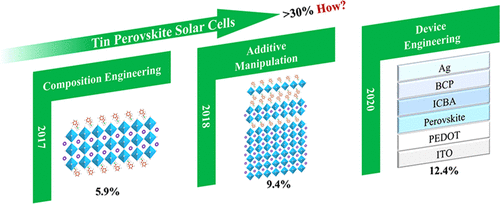当前位置:
X-MOL 学术
›
Acc. Mater. Res.
›
论文详情
Our official English website, www.x-mol.net, welcomes your
feedback! (Note: you will need to create a separate account there.)
Tin Halide Perovskite Solar Cells: An Emerging Thin-Film Photovoltaic Technology
Accounts of Materials Research ( IF 14.0 ) Pub Date : 2021-02-16 , DOI: 10.1021/accountsmr.0c00111 Xianyuan Jiang 1 , Zihao Zang 1 , Yuanyuan Zhou 2 , Hansheng Li 1 , Qi Wei 1 , Zhijun Ning 1
Accounts of Materials Research ( IF 14.0 ) Pub Date : 2021-02-16 , DOI: 10.1021/accountsmr.0c00111 Xianyuan Jiang 1 , Zihao Zang 1 , Yuanyuan Zhou 2 , Hansheng Li 1 , Qi Wei 1 , Zhijun Ning 1
Affiliation

|
Perovskite semiconductors are regarded as next-generation photovoltaic materials owing to their superb optoelectronic properties, including an excellent carrier diffusion length, strong light absorbption, low defect density, and solution processability. The PCE of lead perovskite solar cells (LPSC) rapidly increased from 3.8 to 25.5% in the past decade. However, the inclusion of soluble, toxic lead shadows its application due to environmental concerns. Furthermore, on the basis of the Shockley–Quisser (S–Q) limit, the efficiency of lead perovskite is limited to 32% since its band gap is >1.5 eV. To increase the efficiency of perovskite solar cells further, perovskite materials with a smaller band gap are required.
中文翻译:

卤化锡钙钛矿太阳能电池:新兴的薄膜光伏技术
钙钛矿半导体由于其卓越的光电性能而被认为是下一代光伏材料,包括优异的载流子扩散长度,强光吸收性,低缺陷密度和溶液可加工性。在过去的十年中,钙钛矿形铅太阳能电池(LPSC)的PCE迅速从3.8增加到25.5%。然而,由于对环境的关注,包含可溶性,有毒的铅掩盖了其应用。此外,基于肖克利-奎塞尔(S-Q)限值,由于钙钛矿带隙> 1.5 eV,因此钙钛矿型铅的效率限制为32%。为了进一步提高钙钛矿太阳能电池的效率,需要带隙较小的钙钛矿材料。
更新日期:2021-04-23
中文翻译:

卤化锡钙钛矿太阳能电池:新兴的薄膜光伏技术
钙钛矿半导体由于其卓越的光电性能而被认为是下一代光伏材料,包括优异的载流子扩散长度,强光吸收性,低缺陷密度和溶液可加工性。在过去的十年中,钙钛矿形铅太阳能电池(LPSC)的PCE迅速从3.8增加到25.5%。然而,由于对环境的关注,包含可溶性,有毒的铅掩盖了其应用。此外,基于肖克利-奎塞尔(S-Q)限值,由于钙钛矿带隙> 1.5 eV,因此钙钛矿型铅的效率限制为32%。为了进一步提高钙钛矿太阳能电池的效率,需要带隙较小的钙钛矿材料。











































 京公网安备 11010802027423号
京公网安备 11010802027423号